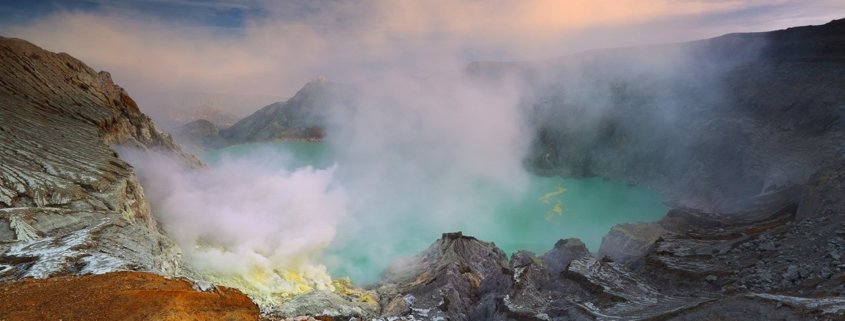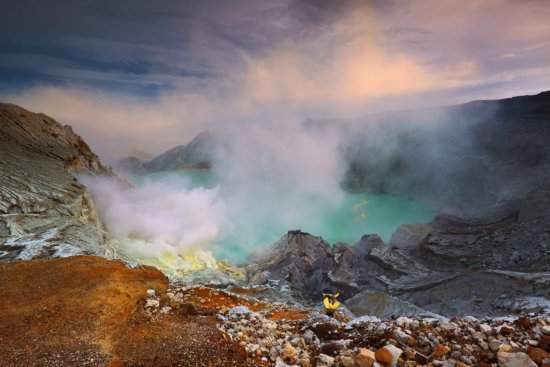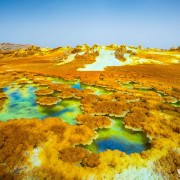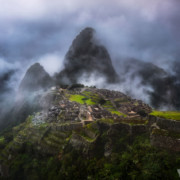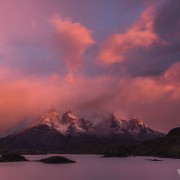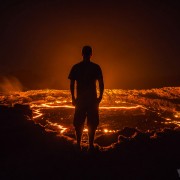Travel Photography at acidic Ijen Crater in Indonesia
Travel photography can lead to destinations all around the world. One of those travel destination is where more than 450 volcanoes sit along the Pacific Ring of Fire, stretching in a horseshoe-like arch from just north of New Zealand, up and around the Pacific coast to Peru and Chile. Scientists estimate that between 100-150 of these volcanoes are still active. This means that 75 percent of our planet’s active volcanoes are located in this area. These volcanoes form the backbone of Sumatra, Java, and Bali. Kawah Ijen (Ijen Crater), in the nature reserve Ijen Park, is located between Banyuwangi and Bondowoso District, East Java, Indonesia. The crater is located at the exact top of Mount Ijen, one of a series of volcanoes in East Java including Raung, Bromo, Semeru, and Merapi.
Kawah Ijen (Ijen Crater) is like no other volcano in the world. It is home to the world’s largest acidic crater lake, the site of a dangerous sulfur mining operation, and the nature phenomenon that known as The Blue Fire.
Getting to Kawah Ijen
To get to the homestay (local hotel) located in East Java, we started from Bali and drove approximately six hours plus spent an additional hour crossing the Bali Strait by ferry. When we reached the homestay located in the coffee plantation area, it was cold and rainy. After a shower and meal, I prepared my camera and all of the necessary gear for my trip to the crater. I had only two hours of rest before we started our adventure!
We left the homestay around 2 AM and drove approximately one hour to the ranger post at Paltuding (1.850m). This is where permits are obtained and guides are available. A moderate three-kilometer track led us through the casuarina forest and up to the volcano rim. Although the track is wide and flat, it is just the beginning. Gradually the trail rises up through some steep sections. Various plants that exist only in the highlands can be found along the way, including edelweis flowers and pine.
After about two kilometers of slow walking, we reached the Pondok Bunder shelter (2.214m). This is the post where miners harvesting sulfur from the crater weigh their loads. The minors, who are carrying sulphur in bamboo baskets on their shoulders along the way to the crater rim are easily recognizable. Always remember to give them the right-of-way and let them pass first. Their profession is considered one of the most dangerous and toxic jobs on earth. You can support them by buying a little sulphur souvenier or by giving them a bottle of water.
After a few minutes rest at Pondok Bunder, we continued to walk the flat trails all the way to the crater’s rim. From here, a beautiful panoramic view made me stop several times to take a photos.
Kawah Ijen Crater Lake
You will know that you have arrived at the crater rim by the smell of sulfur fumes rising from the crater lake. From the edge of the crater rim, you must climb another 300 meters down a narrow steep path to the lakeside to get the best pictures of the lake and blue fire from sulphur mining site.
The crater of Kawah Ijen is about 960 meters x 600 meters with a depth of 200 meters and contains extremely acidic water. The acid measures at almost zero (pH). This beautiful warm crater lake with its blue-green water looks very inviting, but it is corrosive and dangerous. It can dissolve clothes and human flesh!
I’m so glad that I was able to get down to the lakeside to take closer photos of the lake and the miners’ activity. I spent a very short time down there because the area was covered by sulphur smoke and I only had my wet towel to use as a mask.
As an alternative, hike approximately one kilometer to the north-east side of the crater and follow the track. From here, the breathtaking panoramic view of the stunning turquoise lake is simply magnificent. It is a perfect spot to take sunrise or Milky Way photos. With an elevation of 2,799 m (9,183 ft), air temperatures at the crater are cold, usually around 10° Celsius (50°F), although the temperature can drop as low as 2° Celsius (35.6°F). The cold ambient air temperature combined with the heat escaping from the volcanic crater increases the sensation of the experience of visiting Kawah Ijen.
Travel Photography Tips
The best time to start hiking is in the early morning, around 2 AM from Paltuding. By starting early, you will arrive in time to see the blue fire which disappears around 5AM. You can also watch a beautiful sunrise peeping through the mountain tops. Some enthusiast hikers or photographers even start out as early as 9PM to shoot the Milky Way or star trails.
Around 10am, the wind starts to blows the acid smoke of sulfur to the walking path. If you have asthma or any other breathing condition and/or extremely sensitive eyes, I would strongly recommend that you don’t try to get down to the lake. Remember to bring a gas mask and bottle of water. It is hard to climb down to the crater lake or up to the rim when it is covered with sulfur smoke. If you are in this situation and don’t have a gas mask, pour some water on a tissue or handkerchief. Use it to cover your nose and mouth, then breathe only through your mouth. Stay low behind the rocks and don’t panic.
Access to the crater closes at 2 PM due to heavy white sulfuric smoke which makes hiking impossible.
Travel Photography Equipment
As with most travel photography, wide angle lenses, various GND filters, a shutter release cable, and a steady tripod were my camera’s companions when shooting at Kawah Ijen. Definitely grab yourself a pair of hiking boots, bottles of water, and a gas mask. You can also rent a gas mask from a guide at the ranger post at Paltuding.
Now that you know the dos and don’ts about visiting the worlds largest acidic crater lake, the only question is: When are you going to do it? If you have already visited this location before, please feel free to share your own experiences in the comments below.

